This article has been reviewed according to Science X's editorial process and policies. Editors have highlighted the following attributes while ensuring the content's credibility:
fact-checked
trusted source
proofread
New living building material draws carbon out of the atmosphere
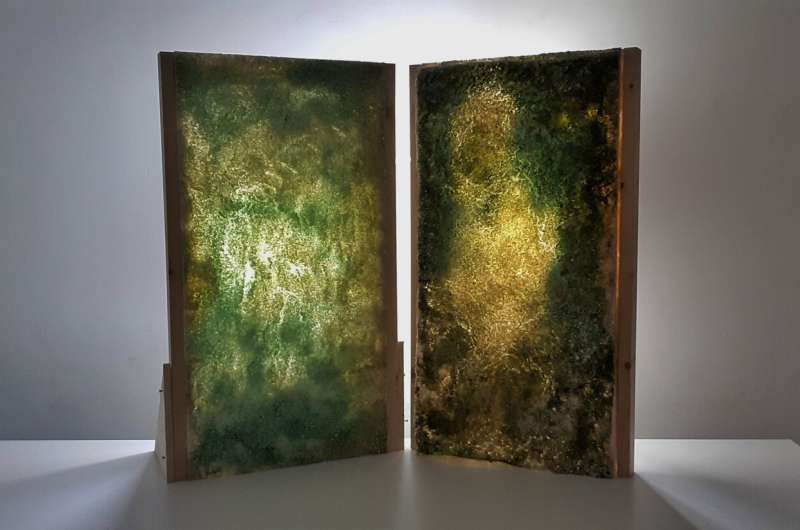
A new construction biomaterial that uses living microorganisms to extract carbon dioxide from the atmosphere has been developed by a UCL graduate student and colleagues.
The biomaterial, developed by a master's student in the UCL Bio-Integrated Design program, could dramatically reduce the construction industry's carbon footprint if mass produced and widely adopted.
It was unveiled as part of an art installation in St Andrews Botanic Garden in Scotland, and incorporates living cyanobacteria into translucent panels that can be mounted on to the interior walls of buildings. As the microorganisms embedded within these panels grow using photosynthesis, they pull carbon dioxide out of the air, and through a biomineralization process, affix it to calcium to create calcium carbonate, locking away the carbon.
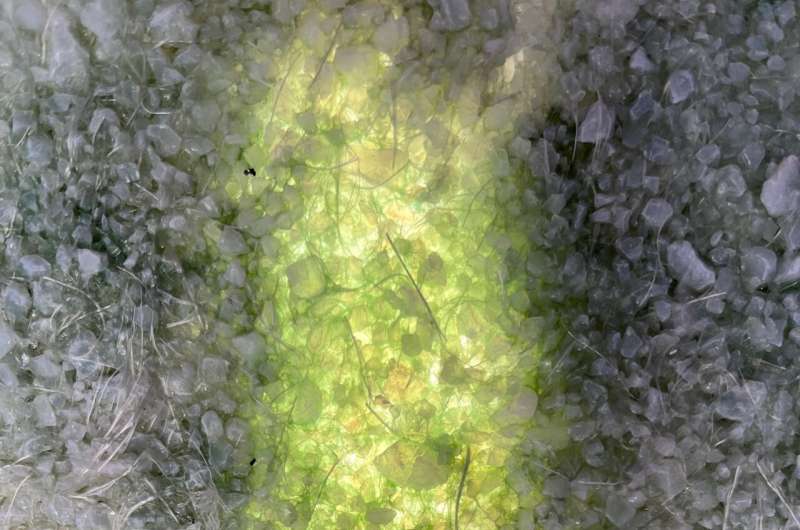
A kilogram of this biomaterial, known as a cyanobacterial engineered living material or C-ELM, can capture and sequester up to 350g of carbon dioxide, while the same amount of traditional concrete will emit as much as 500g of carbon dioxide. A 150-square-meter wall cladded with these C-ELM panels will lock away approximately one ton of carbon dioxide.
Postgraduate student Prantar Tamuli (UCL Biochemical Engineering) said, "My aim by developing the C-ELM material is to transform the act of constructing our future human habitats from the biggest carbon-emitting activity to the largest carbon-sequestering one."
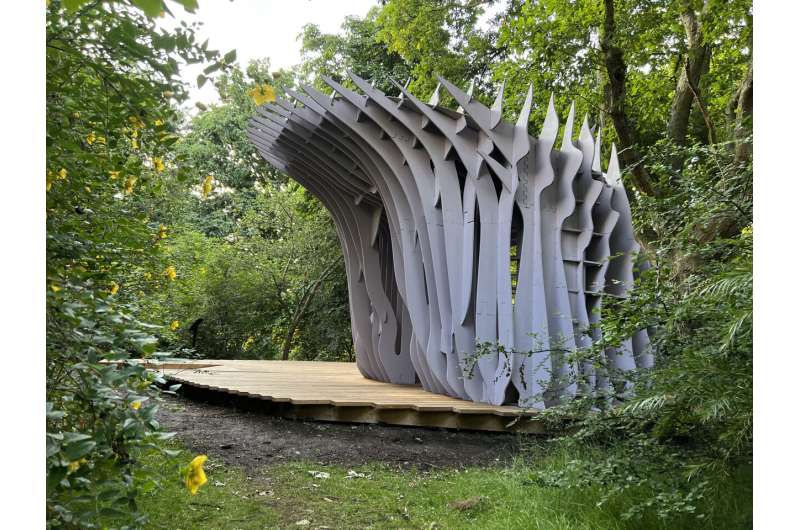
Tamuli was inspired to develop the material by studying stromatolites—natural stony structures formed over millions of years from sediments trapped by some of the Earth's most ancient living organisms, algal mats.
Tamuli developed C-ELM under the guidance of research supervisors during his earlier MSc degree in Bio-Integrated Design. Over the COVID-19 lockdown in London, he developed a new process for culturing the cyanobacteria at his home without access to his lab or conventional equipment. A patent for the C-ELM technology has been filed by UCL's commercialization company, UCL Business.
Tamuli focused on the species Kamptonema animale, a photosynthetic cyanobacteria that grows in long strands, making it easy to bind the microorganisms to the surrounding material within the panels. The calcium carbonate that the cyanobacteria produce helps to strengthen and reinforce the panels.
The panels themselves are designed to offer a range of cosmetic and structural benefits for buildings. They are lightweight, sound-absorbing, translucent enough to transmit light through and thermally insulating so as to enhance the energy efficiency of buildings.
-
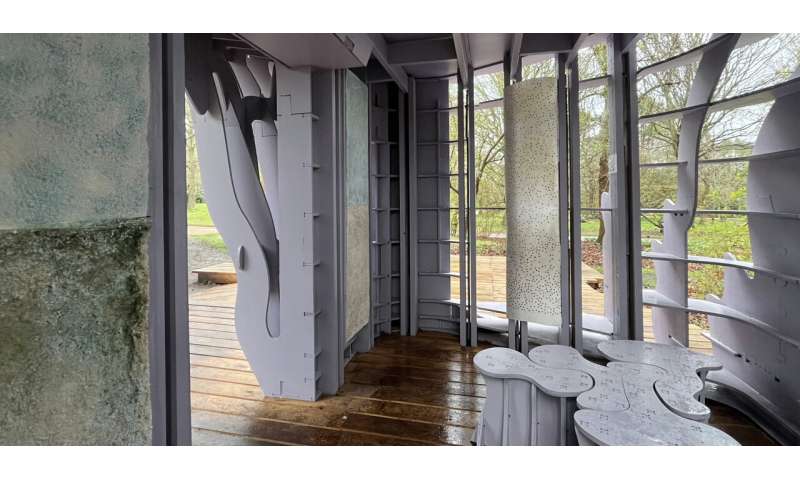
The interior of the Bioscope at St Andrews Botanic Garden. Credit: Marcos Cruz -
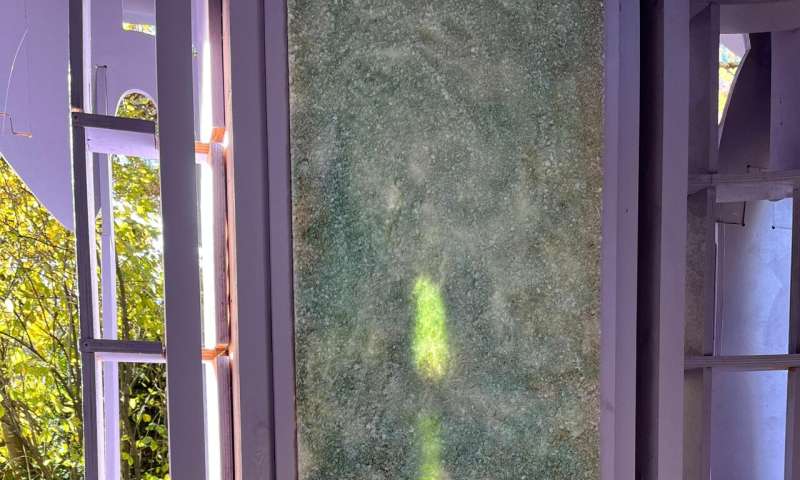
The interior of the Bioscope at St Andrews Botanic Garden. Credit: Marcos Cruz
The first such panels were publicly demonstrated at an installation inside the Bioscope pavilion in St Andrews Botanic Garden in Scotland. Designed by the design collective Studio Biocene, the display showcased low-carbon and low-impact construction methods that mimic a natural environment.
Professor Marcos Cruz (UCL Bartlett School of Architecture and co-director of the Bio-Integrated Design Program) said, "The promise of this kind of biomaterial is tremendous. If mass-produced and widely adopted, it could dramatically reduce the carbon footprint of the construction industry. We hope to scale up the manufacture of this C-ELM and further optimize its performance to be better suited for use in construction."
The Bio-Integrated Design Program at UCL is jointly run by the Bartlett School of Architecture, and the Department of Biochemical Engineering, part of the UCL Faculty of Engineering. Together, the program merges practices from a range of disciplines with the aim of creating a built environment closely intertwined with nature.
Dr. Brenda Parker (UCL Biochemical Engineering and co-director of the Bio-Integrated Design Program) said, "By breaking down traditional disciplinary silos we can enable discoveries such as these. It is an exciting moment where biotechnology has the potential to transform how we design and build more sustainably."
Studio Biocene is a design collective pioneering a bio-integrated green transition, rooted in practice and academia. The team shares an ambition to scale up novel ways of designing with and for living systems, and was co-founded by Professor Marcos Cruz and Dr. Brenda Parker.















